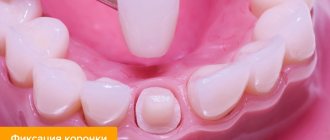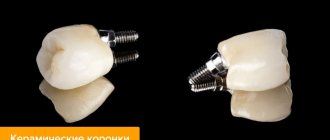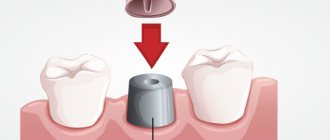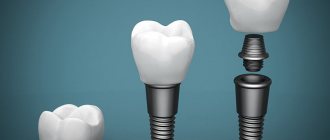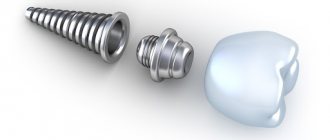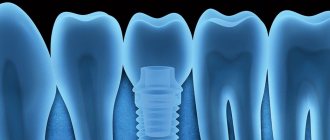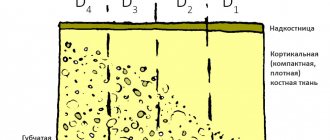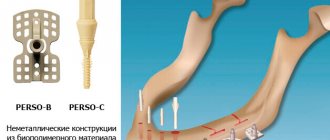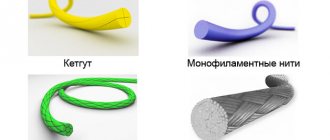- Each implant comes complete with a plug
- The choice of diameter and length of the implant depends on the volume of bone tissue in the patient and the expected occlusal load
- For aesthetic reasons, Bicon implants are designed to be placed deeper than the cortical plate of the alveolar ridge so as to be 5mm below the level of the gum on the vestibular side.
- Implants can also be placed flush or slightly above the ridge if this does not affect subsequent esthetics.
- As a general recommendation, choose the widest possible implant, not necessarily the longest one.
- In the anterior part of the upper jaw, we recommend using implants with an internal diameter of 2.5 mm
- In the chewing region up to the canine, it is recommended to install one implant per tooth, if conditions allow.
- Become familiar with the depth notches on the 2.0mm pilot bur and blade cutters.
Features of the Bicon implant
Any implant system has certain features and differences. The characteristic features that distinguish Bicon implants from similar products include the following:
- The length of Bicon titanium rods is no more than 8 millimeters, while products from other manufacturers are twice as long;
- the area of the implants is approximately three times larger in comparison with analogues due to the increased width of the rod, which ensures their correspondingly higher resistance to external loads and their reliable fastening in the jaw with a short screw length;
- good survival rate is ensured by excellent biocompatibility with bone tissue and high quality titanium alloy;
- due to the small size of Baikon implants, they minimize the risk of damage to bone tissue and gums;
- fixing the system is quite simple; when installing them, there is no need to use special tools or cut tissue;
- There are no fasteners or screws in the mouth, which makes oral care easier and improves hygiene.
Due to their small size, Bicon systems, in comparison with analogues, are distinguished by much higher reliability, stability and stability.
Indications and contraindications
As the manufacturer reports on the official website, Bicon implants are suitable in cases where it is necessary to perform prosthetics as quickly as possible. They are used for standard prosthetics and are suitable for those patients who have an increased risk of complications due to the characteristics of the body.
Using the Baikon system, it is possible to carry out prosthetics without waiting for tissue healing after amputation of a tooth or root. Implants are irreplaceable when the amount of bone tissue is too small to allow the use of products from other manufacturers.
There are no absolute contraindications to the use of Bicon implants. But there are relative cases in which restoration of the dentition is not recommended. These include:
- problematic condition of the oral cavity;
- nervous disorders;
- mental illness;
- diseases that have a viral or infectious etiology;
- caries;
- diseases of the teeth and gums that have developed due to poor oral care;
- chronic pathologies affecting internal organs (the possibility of prosthetics is determined individually);
- impossibility of using anesthetics due to intolerance or medical reasons;
- hypersensitivity to titanium.
Many of the contraindications are removable, so in each case you need to make a decision only after consulting with your dentist.
Types (models) of Baikon implants
Depending on the diameter, length and connection with the Bicon abutment, implants, the price of which is quite affordable, are divided into three model groups:
- Short series. Rod length 8-11 mm, internal connection 3.0 mm, diameter 4.5-6.0 mm. Such products are the smallest in length. They are designed in the form of a cone-shaped connection, completely immersed in the bone tissue, without touching the alveolar nerves. Prevents bacteria from entering the tooth socket;
- Max 2.5 series. Length 8-11 mm, connection to abutment 2.5 mm, diameter 4-4.5 mm. The model is designed for implantation into the front part of the jaw, but installation in other areas is not excluded. The design has a cone shape. There is the possibility of re-implantation if necessary;
- Narrow series. 8-11 mm – length, 2.0 mm – internal connection, 3-4.5 mm – diameter. Designed for installation on the lower jaw in the front part with a small space between the teeth.
Bicon implants
The country of origin of Bicon implants is the United States of America. In 1985, they first appeared on the American dental market. Back then, most dental implants were quite large in size and reached from 12-16 millimeters to two centimeters! Against this background, the miniature 8-mm pins from Bicon Dental Implants seemed unprecedentedly exotic to both doctors and people in need of implantation. But over time, a large number of advantages of this system became obvious, and thanks to the unique design of short bicon implants, this implantation system has proven itself to be very effective and has simply become a win-win option for the treatment of complete or partial edentia.
It goes without saying that the goal of the Bicon Dental Implants specialists was not to shock the sophisticated public with the short length of their implants. The original length and geometry were not an end in itself in this case. Bicon implant is, first of all, unique functional characteristics and the ability to achieve an excellent aesthetic effect. And Baikon implants perform this task 100%.
The reliability and functionality of bicon implants is achieved through the uniform distribution of chewing pressure on the surrounding alveolar bone tissue. Their short length and diameter-to-length ratio were the key to such success.
Also, bicon implants with their original design allow, firstly, to reduce compressive stress in bone tissue to a minimum, and secondly, not to damage its physiological innervation and blood circulation. In addition, they do not damage the mucous membrane covering the alveolar ridge - this makes the gum contour physiological, smooth and natural. The minimum size of the pin increases the possibility of implant engraftment without any inflammatory phenomena or other complications.
Due to the short length of the bicon pin, the implant can be used in those difficult cases where implantation of larger pins is not possible due to the physiological and anatomical features of the structure of the dentofacial system or severe atrophy of the bone crest and the impossibility or ineffectiveness of bone grafting. Thus, the miniature size of bicon implants allows you to avoid the need for bone grafting surgery and greatly reduce the patient’s time and money. Even periodontitis (loss of bone tissue in the alveolar process of the jaw bone) is not a contraindication for these implants, since the bone tissue is minimally damaged.
Bicon implants - advantages:
- Baikon implants are distinguished by excellent fixation in the bone, which is achieved thanks to the unique thread design on the pin. Thus, the area of contact with the bone of bicon implants, compared to other implants, is one third larger.
- Bicon implants do not have a screw connection, which is an undeniable advantage, since screw fixation is often the cause of the development of bacterial infection and peri-implantitis (inflammation of the tissues surrounding the implant). The connection in bicon implantation systems between the abutment and the pin part of the implant is of a rather unusual design - it is beveled, this the type of connection allows not only to securely fix the crown and abutment on the intraosseous part of the implant, but also, being very tight, mechanically prevents the penetration of pathogenic bacteria into the tissue of the peri-implant area. The crown with the abutment is held on the pin due to the frictional force and precise fit of the surfaces. The principle of “cold welding” applies here - this effect is achievable due to the fact that quite significant force is required when installing the abutment.
- The uniqueness of bicon implants also lies in the fact that their use is possible even when there is not enough space in the dentition for the smallest crown due to the characteristics of the bite or due to any dental anomaly. In this case, the abutment is simply covered with a special material, the color of which will perfectly harmonize with the color of the patient’s natural teeth.
- Another undeniable advantage of bicon implants is that they can be installed immediately after tooth extraction (removal) - in one visit. This technique has a number of advantages, the main one being, of course, saving time. But it should be remembered that there are strictly limited indications for immediate implantation, the main one of which is the absence of inflammatory phenomena in the periapical tissues of the root, that is, the bone for immediate implantation must be completely healthy. Unfortunately, this is rarely achievable, so the bicon implant can be used for both one-stage surgery and classic two-stage dental implantation.
- All components of the implants are sterilized and made from pure and inert alloys, which are completely non-toxic to the body and do not cause allergic reactions.
Advantages of Baikon implants
The main advantage of Bicon brand implants is that there is no need to build up bone tissue when installing them. The titanium root takes root in an extremely short time and remains securely fixed.
The list of advantages of Baikon systems is quite impressive. Among the main ones note:
- compared to conventional dentures, installation of Bicon rods takes much less time;
- The titanium root does not cause any complications after implantation;
- artificial teeth are reliable in operation and visually aesthetically attractive;
- the prosthesis is fixed immediately after its installation and does not cause any discomfort to the patient;
- during the implantation process, the risks of damage to soft tissues are minimal;
- installation can be carried out using a two-stage or one-stage method.
Another advantage that sets Baikon implants apart from analogues is the price, which is much lower than prostheses of other brands. The quality of the implants is highly appreciated by doctors and consumers all over the world. Numerous reviews are direct confirmation of their reliability and impeccability.
Implant installation procedure
The implantation process takes no more than one hour and is carried out under local anesthesia. As a rule, immediately after installing the prosthesis, a fixed restoration is made while the tooth heals, so that the patient will have to experience discomfort during this period due to the absence of a tooth.
Temporary restoration allows, firstly, to preserve aesthetics, and secondly, it completely restores the functionality of the tooth. It reliably stabilizes the implants during healing.
After tooth extraction, a special abutment is installed on it, which promotes rapid healing of the soft tissue around the implant. After 3-6 months, when the tissues have completely healed, the temporary abutment is replaced with a permanent one, and the final restoration is attached to it.
To completely restore a tooth or a full row, just three visits to the dentist are enough. How long the whole process will take can be predicted only after an examination by a dentist. If there is a serious lack of bone tissue, then osteoplasty will have to be done, and the process will take about a year. But thanks to Bicon’s thoughtful solutions, the patient will not experience any discomfort during this period.
Rehabilitation after surgery
The first thing that is necessary after implantation is to follow the doctor’s recommendations and maintain oral hygiene. Immediately after surgery, the patient may experience moderate pain, but this is completely natural. Usually after three days the pain disappears.
In the postoperative period, it is very important to monitor the strength of the fastenings, and if even slight mobility is observed, then you should immediately consult a doctor for more reliable fixation and elimination of defects.
Cost of treatment
Many factors influence the price. How much it will cost a patient to install implants depends on the preparatory work, the current condition of the oral cavity, and the presence of chronic diseases. The total price is also affected by the range of products and medications used. It is also important what pricing policy the chosen dental clinic follows, since the difference in cost can reach several times. Average prices for prosthetics are as follows:
- internal diameter 2 mm - 30,000 rubles;
- ext. d. 2.5 mm - 27,000 rub.;
- ext. d. 3 mm - 20,000 rub.
The price is for 1 element. Thus, the patient can independently calculate the approximate amount required for prosthetics, based on how many products of a particular diameter will be installed.
Patient reviews
The difference between Beacon implants and others is that they are driven in with hammers rather than screwed. That's what the doctor told me. On the one hand, this is good, because there is no screw fastening, which can become loose over time. On the other hand, I had some fears: suddenly something would go wrong. After the tooth was removed, I was immediately fitted with a prosthesis and a temporary abutment, and when everything had healed, a permanent prosthesis was secured. This was a few months ago. The tooth functions normally, there is no feeling that there is something foreign in the mouth.
Antonina, Blagodarny
I recommend this brand of dentures to anyone who decides to get their teeth done. I liked it because at an average price the quality is very decent. 3 years after prosthetics, the implants stand like a glove, not a single tooth has become loose. I'm glad that the color of the coating remained the same as it was originally. There is no discomfort when chewing and you can eat absolutely any food, including hard foods. Of course, I wouldn’t recommend cracking nuts or uncorking bottles - you need to take care of your teeth, whether false or your own.
Sergey, Gavrilov-Yam
When the time came to think about installing dentures, I hesitated for a long time.
It seemed that I could not live with artificial teeth. I went for a consultation with my dentist several times - he is one of those people about whom they say “a doctor from God.” So, he said that it was best to buy Baikon implants, although his wife (on the advice of a friend) insisted on the Snukon brand. I followed the specialist’s advice and did not regret my choice. It’s been 2 years now, no problems yet, and the artificial teeth feel no different from their own. Ivan, Nizhnevartovsk
Price
The cost of the Baikon implant may vary. It all depends on the status of the dental clinic, fashionable designs and the number of teeth that need implantation. The average cost of the presented product is 30,000 rubles.
If, after implantation, a person experiences unpleasant symptoms or the product is rejected, then you should immediately consult a doctor. In addition, consultation with a specialist is necessary in cases where there is severe pain when pressing on the prosthesis. All the previously described positive qualities of Baikon implants make this product accessible to many clients. Thus, they are able to enjoy life and not worry about their appearance.
Sources used:
- Ericsson I. et al. Radiographical and histological characteristics of submerged and non-submerged titanium implants // Clin. Oral Implants Res.-1996.
- Illustrated manual on dental implantology (photo album): monograph. / A.I. Zhusev. - M.: Natalis, 2012.
- Smith Nobrega, Adhara; Santiago, Joel Ferreira; De Faria Almeida, Daniel Augusto; Dos Santos, Daniela Micheline; Pellizzer, Eduardo Piza; Goiato, Marcelo Coelho (2016). “Irradiated patients and survival rate of dental implants: A systematic review and meta-analysis.” The Journal of Prosthetic Dentistry.
The difference between the Baikon system and others
Many modern implantation systems include a design that consists of several elements. They are attached to each other using screws. Sometimes, due to poor fit of these components, a gap appears between them. Thus, all food debris and germs penetrate under the prosthesis without any problems. If we consider the baikon system, it consists of 2 elements that are sealed together.
Baikon implants are characterized by the presence of a special design. The dimensions of their surface area are many times higher than the dimensions of other systems. Thanks to this quality, the doctor will be able to use short implants that can be installed on smaller amounts of bone.
The design of the structure in question without a screw connection will allow the implant to be rotated 360 degrees. Therefore, a specialist can use both crowns that are installed outside the oral cavity and those that are modeled directly on the abutment.
